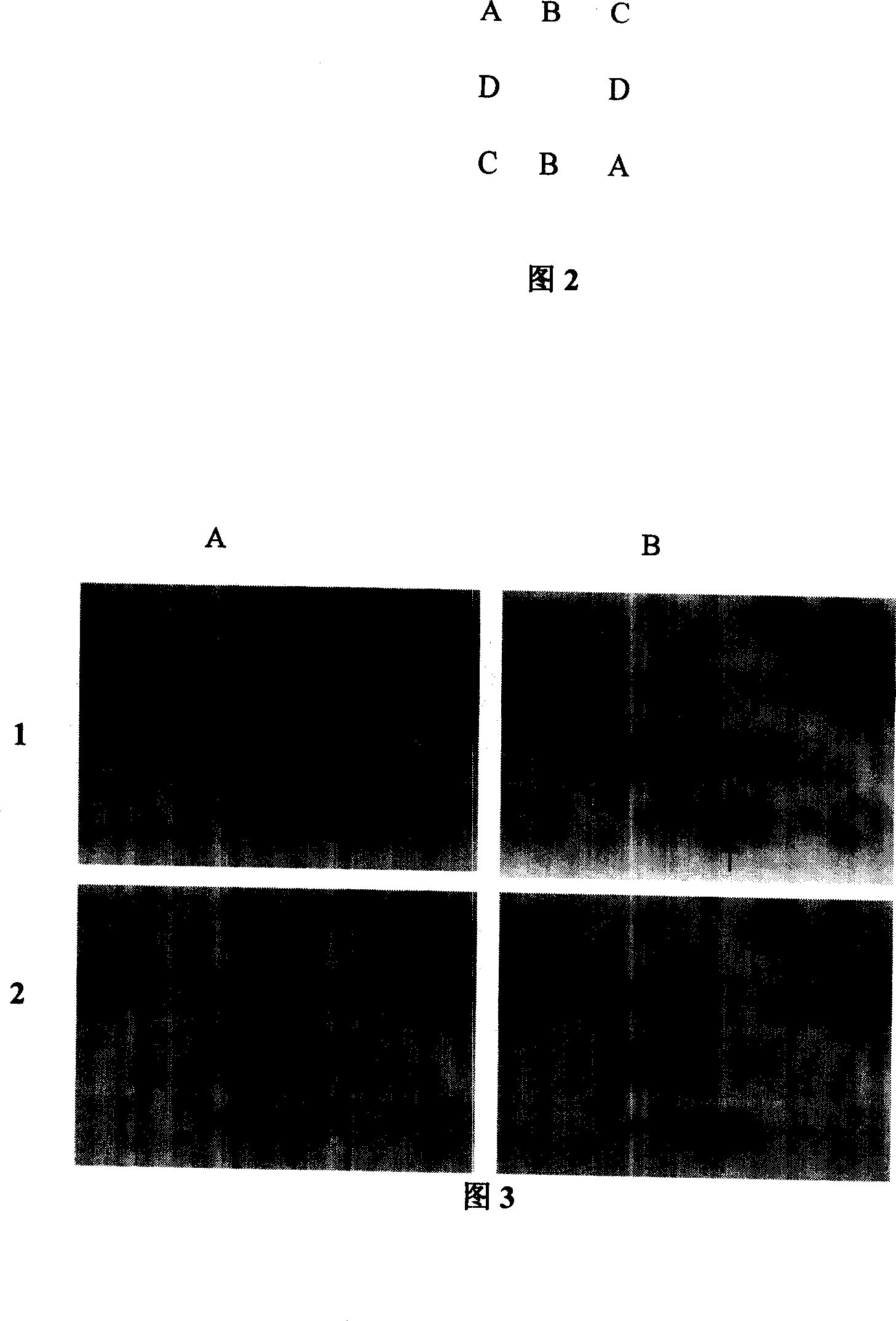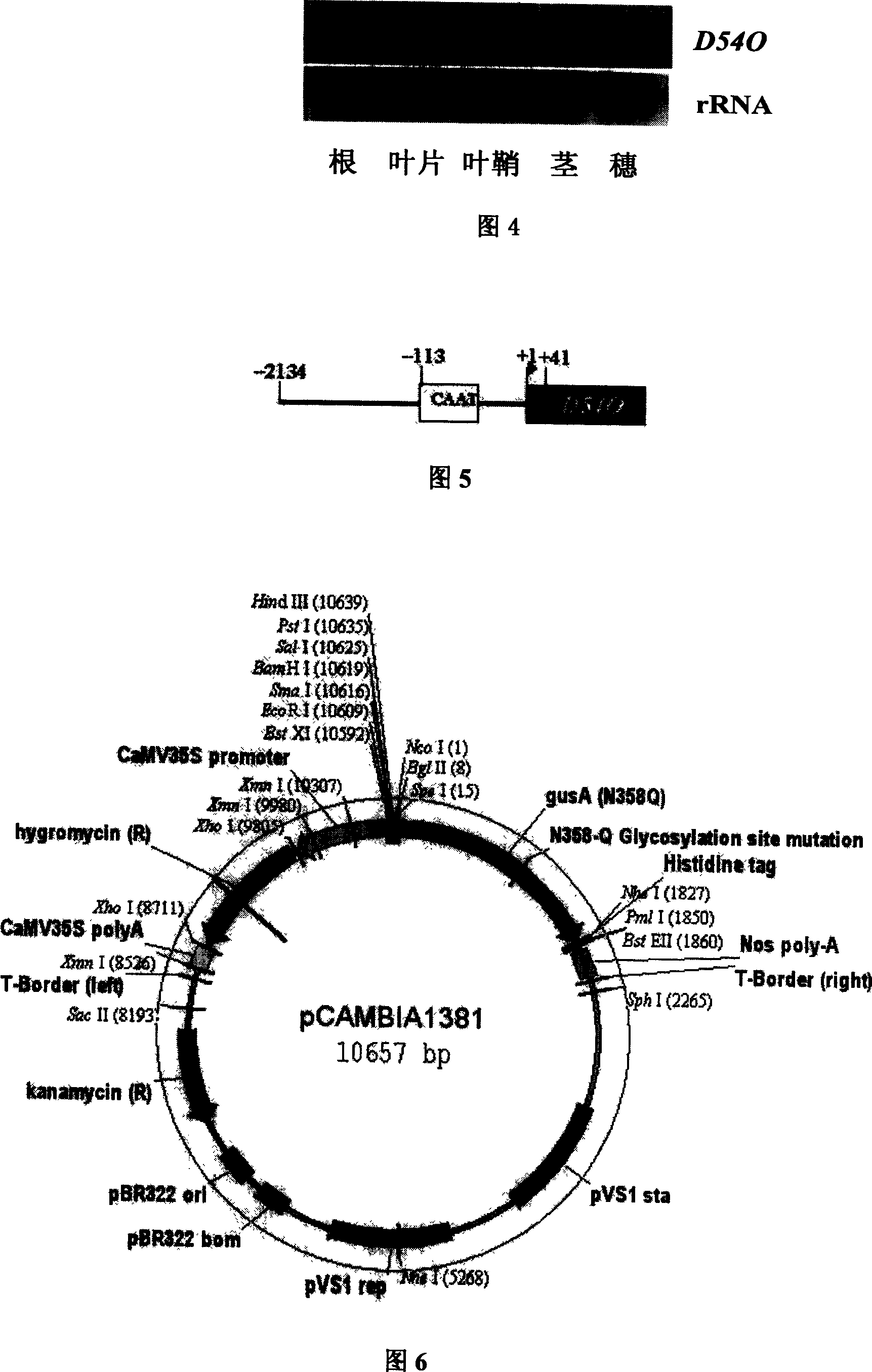Tissue specificity expression promoter PD540 and application of the same in rice modification
A promoter, rice technology, applied in the field of genetic engineering, can solve the problems of waste, plant burden, death, etc.
- Summary
- Abstract
- Description
- Claims
- Application Information
AI Technical Summary
Problems solved by technology
Method used
Image
Examples
Embodiment 1
[0029] Example 1: Isolation of clone P D54O Promoter
[0030] 1. Identification of tissue-specific expression genes in rice using cDNA chip technology
[0031] The present invention utilizes a full growth stage balanced cDNA library of a rice variety Minghui 63 (Oryza sativa ssp. indica), which is widely used in China, for cDNA chip analysis. The library consists of cDNAs from 15 different tissues of rice at different growth stages and different physiological states (Chu et al., 2003). Microarrays were fabricated and analyzed using published methods (Zhou et al., 2002). In order to ensure the reliability of the hybridization results, each cDNA clone has two sites on the cDNA chip, which are located at symmetrical positions on the same grid (Fig. 2).
[0032] The present invention uses total RNA from rice leaves, leaf sheaths, stems, roots, embryos and endosperms to be reverse-transcribed into cDNAs and labeled with radioactive isotopes as probes, respectively hybridized wit...
Embodiment 2
[0041] Example 2: P D54O Functional verification of promoters
[0042] 1. Construction of genetic transformation vector
[0043] The pCAMBIA1381 vector used ( FIG. 6 ) is a series vector of the commonly used Agrobacterium planta-mediated genetic transformation vector pCAMBIA1301 (Sun et al., 2004). This vector carries a promoter-less reporter gene GUS, which was donated by CAMBIA Laboratory (Center for the Application of Molecular Biology to International Agriculture) in Australia.
[0044] According to the sequence analysis results, restriction endonucleases SmaI and SphI were selected to digest the subcloning of the 6.5kb fragment of 119H12 to obtain a promoter fragment of about 2.1kb, which included the region from -2134 to +41 (relative to The translation start codon ATG is +1), named P D54O . The end of the obtained fragment was smoothed with T4 DNA polymerase; at the same time, the genetic transformation vector pCAMBIA1381 was digested with a blunt-ended restriction ...
Embodiment 3
[0047] Example 3: P D54O Promoter application
[0048] 1.P D54O Construction and Transformation of Fusion Vector with Anti-insect Gene Bt
[0049] In order to test P D54OThe application value of the promoter in rice insect resistance, the present invention replaces the reporter gene GUS in the aforementioned pCAMBIA1381 vector with the Bt insect resistance gene Cry1Ac (Cheng et al., 1998), adopts the method described in Example 2 to P D54O The promoter was ligated with the pCAMBIA1381 vector carrying the Cry1Ac gene. The obtained recombinant plasmid was named P D54O -Cry1Ac (Figure 9). Will P D54O - Electrotransformation of the Cry1Ac plasmid (Sambrook and Russell, 2001) into Agrobacterium strain EHA105 (Sun et al., 2004).
[0050] The P D54O The -Cry1Ac plasmid was introduced into the rice variety Mudanjiang 8, and 20 positive independent transformed plants were obtained. Utilize the BT-Cry1Ab / 1Ac gold-labeled immunological rapid detection test strip (purchased from ...
PUM
 Login to View More
Login to View More Abstract
Description
Claims
Application Information
 Login to View More
Login to View More - R&D
- Intellectual Property
- Life Sciences
- Materials
- Tech Scout
- Unparalleled Data Quality
- Higher Quality Content
- 60% Fewer Hallucinations
Browse by: Latest US Patents, China's latest patents, Technical Efficacy Thesaurus, Application Domain, Technology Topic, Popular Technical Reports.
© 2025 PatSnap. All rights reserved.Legal|Privacy policy|Modern Slavery Act Transparency Statement|Sitemap|About US| Contact US: help@patsnap.com



